#API Q1
Explore tagged Tumblr posts
Text
In the dynamic and high-stakes environment of the oil and gas industry, ensuring consistent quality and minimizing risks is essential for operational excellence. API Spec Q2, the standard developed by the American Petroleum Institute (API), plays a pivotal role in achieving these goals. This article explores how API Spec Q2 can help your business enhance its operations, reduce risks, and maintain a competitive edge.
0 notes
Text
API Q1 Consultancy in India | AVN PROFESSIONAL QUALITY – Your Certification Partner
AVN PROFESSIONAL QUALITY provides expert API Q1 consultancy in India, guiding organizations in the oil and gas sector through seamless implementation and certification of API Q1 standards. Our experienced consultants offer end-to-end support, including gap analysis, documentation, training, and audit preparation to ensure full compliance. Partner with us to strengthen your quality management system and achieve API Q1 certification with confidence.

0 notes
Text

How Many Do You Know?
A–Z of API Certification Abbreviations
Here’s your quick-hit A–Z glossary of the most common abbreviations you'll encounter in API Q1, Q2, and Monogram programs.
#APIStandards#QualityManagement#OilAndGas#APICertification#apicompliance#ManufacturingExcellence#VegasConsulting#API Spec Q1#API Spec Q2
0 notes
Text
AVN PROFESSIONAL QUALITY – Expert API Q1 Auditor Training for Quality Management Excellence
AVN PROFESSIONAL QUALITY provides industry-leading API Q1 auditor training designed to equip professionals with the knowledge and skills to audit quality management systems in accordance with API Specification Q1 standards. Our comprehensive training ensures compliance, enhances auditing capabilities, and supports continuous improvement in the oil and gas sector.

0 notes
Photo
Stealing/boosting id from consistantly-changing
[Image descriptions in order: two screenshots of a Reddit post by u/iambeaker titled "'Twas the night before my resignation…" The post reads "I was brainwashed at an early age that loyalty and hard work would add countless "0's" to your paycheck. I remained optimistic after receiving year after year of 3% raises and working holidays. I missed my children's first steps, their school functions, and other life events so I could make the CEO more money.
After the passing of my stepfather and my boss calling me during the funeral, asking me to troubleshoot an issue while my mom cried into my shoulder, enough was enough. I changed companies and made a personal pledge to put family first and my career a distant third or fourth.
Fast forward to present day…. I find myself as the cornerstone of our department. Many of our clients' processes are automated through custom API developed by me. I have maintained a thorough documentation library on how to support the API, the reports, and all of its dependencies. I have offered to train backup so we are not single threaded. My manager told me "No way, we would never do anything to lose you!" Up to now, life was good.
At the beginning of December, ABC Company was audited by the government and found to be out of compliance. They hired my company to regain their compliance by the end of the year or risk fines near $750,000. ABC Company dragged their feet getting us the information we needed to start on the work.
I save my vacation days so I can take the week between Christmas and New Years off. I spend it with my kids to make up for all the time I lost when I worked when they were younger. This time is very precious to me.]
["Last week and this week, I have been notifying the project manager and my manager about my time off. I let them know I would need ABC Company's information soon so I can start on it. I offered to work extra hours to ensure my piece would be finished prior to Christmas Eve.
On Tuesday, my manager calls me and tells me ABC Company finally sent the data over I requested over two weeks ago. He looked beaten because he knew what was about to happen. I told him who should I walk through the project with because I'm off after Christmas. My manager says, "I'm sorry. But I have to ask you to work. I declined your time next week."
I asked, "What happens to my vacation time?" My boss says, "I'm sorry. You know the rules. Use it or lose it. I fought for you but HR wouldn't budge."
I drafted my resignation letter after the call, set it to delay delivery on Monday at 8am, and closed up shop.
ABC Company will pay $700,00 because nobody knows how to program that system since there is no back up. Our other clients will be expecting their monthly, quarterly, and annual reports within the first week of January. No one knows how to do this. We had six projects in progress involving extensive API and reporting, now those projects are dead in the water. Seven clients prepaid for API and automation upgrades in 2022 Q1. I don't know what will happen to those.
Please remember. Family first. You never get that time back."]
[Several screenshots of a text conversation between OP and their boss. It goes:
Boss: Hope you have a great Christmas
Boss: [OP] please call me as soon as you can.
Boss: I received your email. I understand that you are upset but resigning is not the best choice in this circumstance.
Boss: [OP], I have been your friend for five years. I'm asking you as a friend, not a manager to reconsider and call me. Let's talk about this
Boss: Hey, you made your point. You can have today off if you call me and let me know when we can expect you tomorrow. But you need to call me.
Boss: This is ridiculous. Do you know what your actions are going to do to the company? To me? You made your point. Just call me and we will figure out your vacation. But we need]
[Boss: This is ridiculous. Do you know what your actions are going to do to the company? To me? You made your point. Just call me and we will figure out your vacation. But we need [task] done by Friday.
Boss: Why won't you answer your phone? Your wife won't answer hers either. HR needs to talk to you.
Boss: I got out of a meeting with [name]. If we don't get this done for [client] we get penalized and that $ comes from bonus and pay increases. I want you to know that. If you don't finish that, nobody gets a bonus or a pay increase this year. This will be common knowledge
Boss: [OP], I've been talking to [name] We assume you resigned because you were going to lose your vacation. Here's the deal… if you call me by 3, we will rollover your vacation to 2022, but we still need you to work T-F. We need [task] done before 12/31. Call me before 3]
[Boss: [name] sent over a Corrupt CSV file and [name] followed your documentation to manually process it. [Name] tried python and the states can't see their dailies. You gotta help us here Call me!!!
Boss: Dude, log back in and help fix this stuff. Name your price. The states can't see their reports. [Company's] going to fine us [name] wants to know if the reports will be complete by 1/6. Family is important, but we are talking about peoples jobs on the line.
OP: Hey, I will be happy to return to [company] for $80/hour, $5000 immediate sign on bonus, and 6 weeks PTO. With a 12 month guarantee. Send that to me in writing and I'll start immediately.
Boss: Cmon. This is ridiculous. I don't even get paid that much. Why do you think you deserve this much? Quit being so full of yourself, be a team player, login and save this company.
Boss: Pick up your phone. I need to know what reports are due next week. We don't want to be fined.]
[Boss: Not even a counteroffer? Every hour the dailies are down, that's $1000 per STATE. [Name] does not know how to fix it. I don't know how much clearer I need to be. Log back in, fix his mistake, get [task] done, be a team player. We are family too you know.
OP: Please stop calling my dad. He has nothing to do with this. You can call me all you want but don't call my emergency contacts. I resigned, I didn't die.
Boss: We had to make sure you were ok.
Boss: Congrats [OP]. You cost the firm $19k. You taught us a lesson. Now pick up the phone and we talk about a reasonable offer. But you need to fix this states daily thing right now. That is your priority
Boss: Pick up the phone HR wants to conduct their exit interview]
[Boss: [OP], here are your priorities
Fix state dailies
Complete [task]
Provide [name] list of 1/6 reports
Train [name] being your back up
Boss: How much time will it take to fix the dailies? I need to tell [name]
OP: What does this mean? To be 100% clear, I resigned today. I don't have priorities or projects. I am no longer an employee. If you would like me to return, I gave you my offer
Boss: There was a time when a two week notice would before you resigned. Maybe you should be a better businessman and give us two weeks? [OP], we all make sacrifices. You have to sacrifice one week of vacation so we can fix some stuff around this department. Next year, maybe you won't ask off for this week until closer to December and you know what the workload is. You gambled and you lose. Just laugh it off and log on, let's get these states fixed. Let's fix [company]. Let's get this department fixed
Boss: Pick up your phone. It is [name] and me We need to know what it's going to take to fix the state dailies. $19k/hour is going to murder us
Boss: [OP] answer your phone
Boss: ANSWER YOUR PHONE!!!
OP: For $10,000, I'll fix your state daily file and train the team on how to run it so this doesn't happen again. Nobody is familiar with Python or understands Alteryx or SSIS. I can train them all using my existing documentation. The answers are all there.
OP: I can fix the state daily file tonight to avoid further fines and train the team the rest of the week. But I will NOT do any work on [project] or provide any information about recurring reports.
Boss: Is that some kind of joke? Your documentation does not have the answer. We've been through it [censored] laughing at $10k. You already cost us $32k today, you want to squeeze another $10k. You got greedy over Christmas]
[Boss: $10k
Fix daily files
Train the team
Do the [project]
Run the recurring reports for January
Deal?
Then we are done.
OP: That is a generous offer. But I'm firm on my offers. But I'm telling you, you don't need me. The answer is in the documentation.
Boss: Then where is it? If you were a true person of your word, you would tell us and save this company. Save your coworkers. Save their paychecks and their bonuses.]
[A gif of Homer Simpson driving. He turns behind him to shout angrily, then the camera changes to a wide shot where he drives over a short wooden bridge, throwing a lighter onto it and lighting it on fire.]
[An update from the OP, which says, "Present Day:
Throughout the day, the manager and CEO send a barrage of texts and phone calls.
One of my coworkers finds the documentation and fixes the reports. Later in the afternoon, he is served corrective action because he was accountable for processing the corrupted file and did not find the documentation faster. He tells me the manager, HR, and the CEO spent all night finding evidence to support the corrective action. I tell him to get his resume up to date. Total down time: 16 hours
Around 3pm, I get a phone call from a new number. It was the client's business manager (the liaison between the former company and the client). I explained to her the delay of getting data until Christmas (despite multiple requests), the loss of a full week of PTO, the text messages/phone calls, and my offer to come back to help her company reach compliance.]
["The business manager told me a different story. The manager and CEO called her earlier to inform her I quit and I am "stalling the project as ransom" in order to obtain more money. I explained how one could skew this view, but I am not actively seeking to return. After observing how the company treats their employees and after being treated post resignation, I have no interest in returning to the company.]
["The business manager asks me what terms (rate, signing bonus, etc.) what I was seeking to return to my former company. She tells me she will call back in an hour and not respond to any more texts from the manager or CEO.
CEO Text: Did the business manager call you? Did she give you a piece of her mind?
Manager Text: I bet the business manager is going to make you personally pay for that fine!
The business manager calls me back on a conference call and asks, "What do you need to finish this project? Software, data, tools, etc.?" I give her a list of everything I need. I answer other questions related to the project.
She says, "Here's the plan. We are going to offer you a contract to finish this API for us by the end of the year for double the hourly rate you asked. If you can finish by 12/31, we will give you the signing bonus. After the New Year, we will see where we are staffing wise and maybe, we can find you a spot, but there is no guarantee, especially if you do not the project. Is that a deal?"]
["I agree to the terms. I inform to put terms in writing and I can start as soon as IT gives me a virtual machine. The business manager says, "No problem, legal checked the contract and there is a clause stating if your former company is unable to perform a function which they agreed to do, we are able to outsource it to a third party and charge the company for it. I just need them to state they are unable to perform the API function, and we will bill them for your time."
TLDR; The client is giving me a contract and billing my former company double my asking rate because the former company is unable to successfully execute a function by the deadline they agreed to in a contract."]
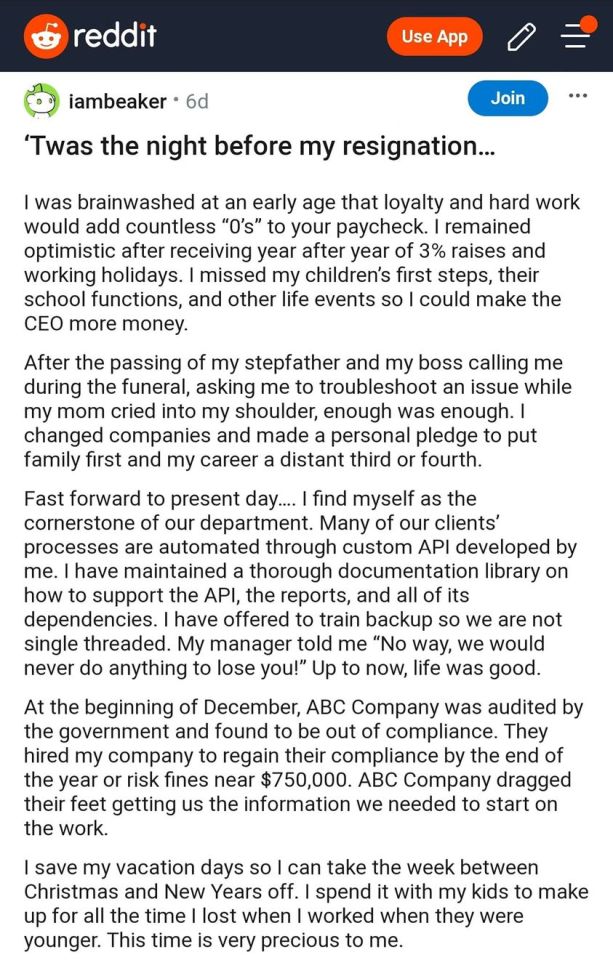
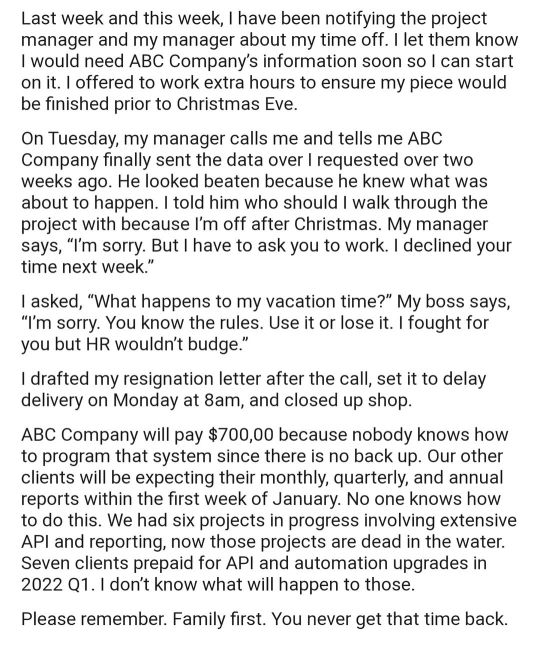


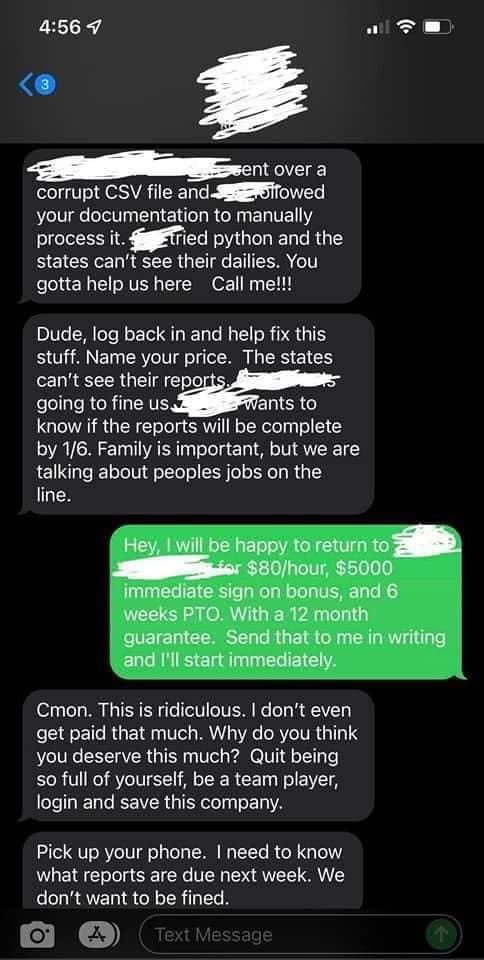

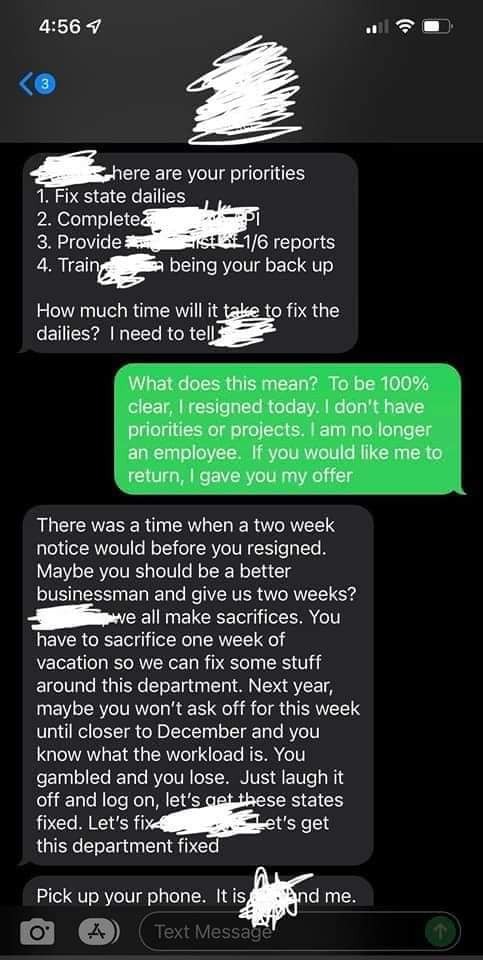

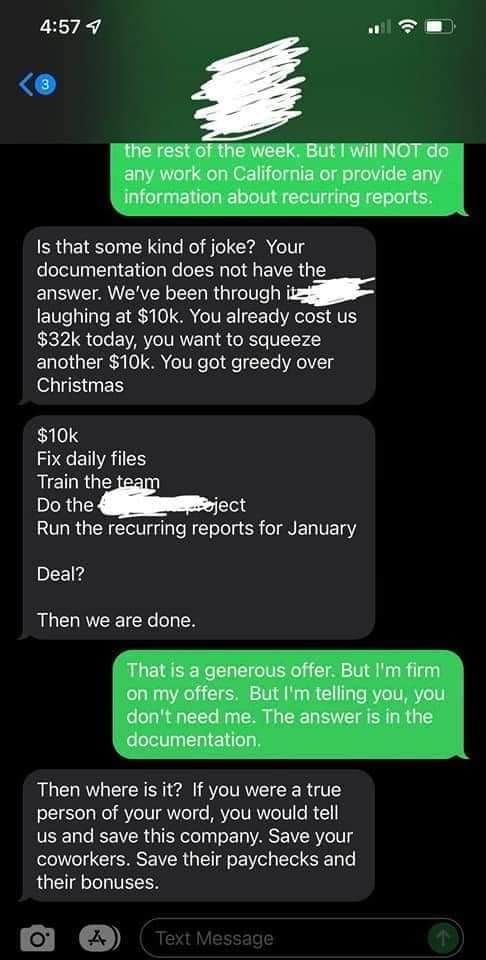

247K notes
·
View notes
Text
Boost Your Business with Oman’s Leading App Developers
In today’s digital-first world, businesses must evolve quickly to keep pace with customer expectations and competition. Whether you run a local startup or a well-established brand, embracing digital transformation isn’t just a trend — it’s a necessity. And where better to start than with a custom mobile app built by Oman’s leading app developers?
From Muscat to Sohar, the demand for smart, scalable, and secure mobile solutions is growing fast. Partnering with top-tier talent in mobile app development company in Oman could be the smartest move for your business this year.
📲 Why Mobile Apps Are Essential for Omani Businesses in 2025
Oman’s business landscape is shifting. Consumers expect quick services, real-time updates, and 24/7 accessibility — all through their smartphones. That’s why more businesses are turning to professional app development services in Oman to future-proof their offerings.
Here’s what a custom app can do for you:
Increase customer engagement
Improve operational efficiency
Offer mobile-first experiences
Support digital payments and online bookings
Build brand loyalty with personalized features
When developed properly, an app isn’t just a tech tool — it becomes an extension of your business.
🏆 Who Are Oman’s Leading App Developers?
The Sultanate is now home to several development firms offering world-class mobile solutions. However, not all companies understand the local market the way Oman-based developers do.
One company that consistently delivers outstanding results is Five Programmers. Known for blending cutting-edge technology with deep cultural understanding, Five Programmers has helped numerous Omani businesses build apps that perform, scale, and deliver real ROI.
🛠️ Key Services Offered by Top App Developers in Oman
Whether you need a simple booking platform or a full-scale enterprise application, Oman’s top development teams offer:
Custom iOS and Android App Development
Cross-Platform Development using Flutter and React Native
UI/UX Design Focused on Arabic & English Audiences
Real-Time Analytics Dashboards
API Integrations with Local Payment Gateways
Post-Launch App Maintenance & Upgrades
By choosing a team with a strong local presence, like Five Programmers, you ensure your app is aligned with both Omani business culture and global mobile standards.
🚀 Industries Benefiting from Mobile App Development in Oman
Let’s take a look at how various sectors are integrating apps to boost productivity and growth:
🛍️ Retail & E-Commerce
Build user-friendly shopping apps with secure checkouts, loyalty systems, and delivery tracking.
🏥 Healthcare
Enable appointment bookings, telehealth services, and e-prescriptions through HIPAA-compliant apps.
📚 Education
Launch e-learning platforms, virtual classrooms, and attendance management tools.
🚚 Logistics & Transportation
Track vehicles, manage fleets, and update deliveries in real-time.
🏨 Hospitality & Tourism
Let users book hotels, tours, and explore Oman through interactive mobile guides.
All these apps become more powerful when built by experienced Oman app development companies who understand the country’s digital maturity and expectations.
💼 Real Business Transformations with Five Programmers
Here are just a few ways Five Programmers has helped local businesses scale through mobile app development in Oman:
Developed a logistics app that reduced delivery time by 35% for a courier company in Muscat.
Built a bilingual appointment management app for a private medical clinic in Sohar.
Created a full-featured e-commerce app for a traditional crafts shop in Nizwa, boosting online orders by 50%.
Their expertise goes beyond writing code — it’s about solving real problems for real businesses in Oman.
💬 FAQs – Mobile App Development in Oman
Q1: How long does it take to develop a mobile app in Oman? A basic app may take 6–8 weeks, while complex apps with custom features can take 3–4 months. Five Programmers uses agile sprints to deliver fast, flexible results.
Q2: Can I build a bilingual app in Arabic and English? Yes, this is highly recommended for the Omani market. Local developers specialize in bilingual mobile apps that serve both audiences effectively.
Q3: Will the app support local payment gateways? Absolutely. Top developers integrate with payment systems commonly used in Oman, such as OmanNet and international options like Visa/MasterCard.
Q4: Can I get ongoing support after the app is launched? Yes. Reliable firms like Five Programmers offer ongoing maintenance, updates, and feature enhancements after launch.
📞 Let’s Build Your App – Right Here in Oman
If you're ready to go mobile, don’t settle for generic solutions. Work with professionals who understand your business, your audience, and your goals.
📲 Contact Five Programmers today to get started. 💬 Request a Free Quote tailored to your app idea. Let’s build something powerful together — locally developed, globally competitive.
✅ Final Thoughts: Your Business, Elevated with Mobile Technology
In 2025, digital convenience is no longer a luxury — it’s an expectation. Whether you’re trying to reach more customers, improve efficiency, or offer on-the-go services, a well-built app is the key to unlocking that potential.
And there’s no better way to start than by working with the best in the field. Five Programmers, along with other leading names in the region, are paving the way for digital transformation through custom mobile app development in Oman.
Let your business grow — smarter, faster, and locally.
#mobile app development company in Oman#mobile apps in Oman#flutter app development company in Oman#technology#tech
0 notes
Text
Clopidogrel Prices Index: Trend, Chart, News, Graph, Demand, Forecast
In North America, the Clopidogrel Bisulfate API market experienced considerable fluctuations throughout the first quarter of 2025, driven by changing demand patterns, logistical recalibrations, and currency-related pressures. The quarter began with a significant dip in prices during January, as pharmaceutical manufacturers and regional buyers curtailed procurement in response to regulatory uncertainties and lackluster end-user demand. This subdued buying environment, combined with strategic inventory control and cautious raw material sourcing, led to lower production rates and reduced factory utilization. Market sentiment remained bearish during this period as an oversupply situation persisted, exerting further downward pressure on pricing.
However, February marked a noticeable shift in momentum. Seasonal factors contributed to increased demand for cardiovascular treatments, a category in which Clopidogrel Bisulfate plays a key role, prompting downstream buyers to resume procurement activities. Importers responded by replenishing stockpiles to safeguard against future logistical hurdles, helping stabilize the market. By March, inventory levels were more aligned with actual consumption patterns, and the market atmosphere became cautiously optimistic, supported by consistent demand and balanced supply conditions. The overall pricing landscape for Q1 2025 in North America was characterized by early softness that gradually gave way to recovery, as improved buying activity and strategic stock management helped correct prior imbalances and inject confidence into the sector.
Get Real time Prices for Clopidogrel Bisulfate: https://www.chemanalyst.com/Pricing-data/clopidogrel-1529
The Asia Pacific region’s Clopidogrel Bisulfate API market displayed a dynamic pricing trend across Q1 2025, shaped by initial oversupply and subdued demand that eventually transitioned to a recovery phase. The quarter opened with pronounced bearish sentiment in January as prices declined amid weak pharmaceutical sector demand and high inventory carryovers from the previous quarter. Despite healthy production activity and reliable raw material availability, buyers in key exporting countries held off on bulk purchases, expecting further price drops under persistent macroeconomic uncertainties. These conditions fostered an oversupplied market environment, with limited trading momentum. February brought a significant turnaround, as seasonal restocking and renewed procurement cycles reenergized downstream demand.
Export competitiveness improved with regional currency depreciation against the U.S. dollar, enhancing margins for local suppliers and boosting shipment volumes. Policy changes, such as tax exemptions on specific medicinal products, further encouraged market participation and improved sentiment across the pharmaceutical value chain. Demand for cardiovascular therapeutics, a core segment for Clopidogrel Bisulfate, surged during this period, reinforcing the price rebound. March saw a moderation in demand growth, yet stable purchasing activity and well-managed supply channels maintained price levels. By the end of the quarter, the Asia Pacific market had largely recovered from early-quarter pressures, with pricing trends reflecting a well-paced correction supported by firm fundamentals and favorable export dynamics.
In Europe, the Clopidogrel Bisulfate API market navigated a sequential pricing evolution throughout the first quarter of 2025, influenced by regional demand variability and broader global pharmaceutical trends. January began on a weak note as market participants across the continent enforced strict inventory management practices, reacting to regulatory ambiguity and sluggish export orders. Manufacturing operations remained consistent, and sufficient raw material inflows led to an accumulation of supply that outweighed demand, suppressing prices during the initial month. While production costs remained stable, hesitant buying and excess availability extended the bearish pricing environment. The scenario began to shift in February with a resurgence in pharmaceutical procurement, particularly in the cardiovascular segment, which elevated transaction volumes and lifted prices.
This was aided by favorable trade developments and government-backed initiatives aimed at strengthening healthcare infrastructure, which translated into greater confidence and spending within the pharmaceutical industry. March further solidified the recovery, with supply and demand reaching a more balanced state due to effective inventory rationalization. Pricing remained steady as market participants adjusted operations in line with improving fundamentals. The European Clopidogrel Bisulfate API market concluded the first quarter with a marked transition from early declines to mid-quarter rebound and eventual consolidation, shaped by adaptive demand cycles and external economic drivers that gradually reinforced price stability.
Get Real time Prices for Clopidogrel Bisulfate: https://www.chemanalyst.com/Pricing-data/clopidogrel-1529
Contact Us:
ChemAnalyst
GmbH - S-01, 2.floor, Subbelrather Straße,
15a Cologne, 50823, Germany
Call: +49-221-6505-8833
Email: [email protected]
Website: https://www.chemanalyst.com
#Clopidogrel#Clopidogrel Price#Clopidogrel Prices#Clopidogrel News#Clopidogrel Market#Clopidogrel Pricing
0 notes
Text
Revolutionizing Water Measurement with the Best Ultrasonic Water Meter
In a time where smart technology is reshaping industries, the need for accurate, reliable, and real-time water monitoring has never been more critical. WCO Global stands at the forefront of this transformation with its innovative approach to water management through cutting-edge ultrasonic water metering solutions.
If you are seeking the most precise and maintenance-free solution for water metering, the best ultrasonic water meter from WCO Global offers a powerful answer to modern water challenges.
What Is an Ultrasonic Water Meter?
An ultrasonic water meter uses sound waves to measure the velocity of water flow. Unlike traditional mechanical meters, it has no moving parts. This technology enhances accuracy, durability, and long-term performance—especially in harsh environments where sediment, air bubbles, or low flows can skew mechanical readings.
WCO Global’s ultrasonic meters are engineered for residential, commercial, and industrial applications, ensuring smart water usage, leak detection, and efficient billing through automated data collection.
Why Choose WCO Global’s Ultrasonic Meters?
At WCO Global, our commitment goes beyond hardware. We deliver an end-to-end water management ecosystem integrated with next-generation technologies like LoRaWAN, NB-IoT, and cloud-based analytics.
Key Benefits:
High Accuracy: Delivers consistent readings up to R500 standards.
No Moving Parts: No mechanical wear and tear, ensuring longevity.
Remote Monitoring: Compatible with smart communication protocols like LoRa & NB-IoT.
Real-Time Data: Enables predictive maintenance and water conservation.
Multi-Application Use: Ideal for residential, industrial, and commercial sectors.
Smart Water Management with IoT Integration
The integration of IoT allows water utilities and housing societies to monitor usage patterns, detect anomalies, and automate billing with minimal human intervention. WCO Global’s meters enable this transition with seamless connectivity and secure data transfer.
This ensures:
Reduced water losses
Timely identification of leaks or tampering
Streamlined data-driven decision-making
Applications of Ultrasonic Meters
WCO Global’s meters serve a broad spectrum of clients, including:
Urban water supply authorities
Smart city infrastructure developers
Industrial plants
Real estate developers
Housing societies
Each product is tailored to deliver scalable solutions that align with the digital transformation goals of public and private sector entities.
Sustainability and Compliance
WCO Global is committed to supporting India’s Jal Jeevan Mission and smart city initiatives. Our meters are not only environmentally friendly but also designed to comply with international quality and metrology standards. They operate reliably under extreme pressure, temperature, and water quality variations.
Frequently Asked Questions (FAQs)
Q1. What makes an ultrasonic water meter better than a traditional meter? Ultrasonic water meters use sound wave technology to measure water flow without moving parts, which increases accuracy, reduces maintenance, and extends the meter's life.
Q2. Can these meters be integrated with smart city infrastructure? Yes, WCO Global’s ultrasonic meters are fully compatible with smart city platforms via LoRaWAN and NB-IoT communication technologies.
Q3. Are ultrasonic water meters suitable for domestic use? Absolutely. Our meters are designed for both residential and commercial use, offering the same high-level performance across different scales.
Q4. How is data from the ultrasonic meter accessed? Data can be accessed remotely in real-time through secure cloud platforms or API integrations, depending on the model and network setup.
Q5. Do ultrasonic meters require maintenance? Minimal maintenance is required due to the absence of mechanical components. This makes them highly cost-effective over the long term.
Partner with WCO Global
WCO Global is proud to be a trusted provider of advanced water metering solutions across India. Our focus is on offering reliable products and end-to-end support to clients looking for accurate, automated, and smart water monitoring systems.
Looking to upgrade your water management system? Choose the best ultrasonic water meter with WCO Global and step into the future of intelligent resource management.
0 notes
Text

🛠️ HEAVY-DUTY MOBILE WORKOVER RIGS — BUILT FOR TOUGH JOBS When downtime is not an option, trust the rigs that deliver.
🔹 Hook Load Capacity: Up to 180,000 lbs 🔹 Workover Depth: Up to 12,000 ft 🔹 Engine Power: Up to 335 HP 🔹 Standards: API Q1, 4F, 7K, 8C & HSE-Compliant
With a compact structure, high-efficiency hydraulic + mechanical drive, and front-open mast design, these rigs are built to handle the most demanding well servicing tasks — anywhere, anytime.
📬 Contact us to request specifications or schedule a consultation.
0 notes
Text
Selecting the Right API Q1 Consultancy Services for Your Business
Ultimately, combining API Spec Q1 consulting with targeted training ensures both immediate compliance and sustainable quality management. With several providers offering API monogram consultancy in India, it’s crucial to choose a partner who aligns with your business goals and understands the unique operational challenges of your sector. By doing so, you not only ensure certification success but also build a stronger, more resilient organization.
Visit us:https://www.avnprofessional.com/know-about-api-monogram-program-and-api-consultancy-in-india/
0 notes
Text
Vegas Consulting Group is a dynamic and forward-thinking firm dedicated to transforming businesses through strategic guidance and innovative solutions. At Vegas Consulting we offer reliable services like API Spec Q1, Q2, and monogram consulting, design packages, audit services, ISO certification assistance and comprehensive training programs.
Our Goal is to improve the oil and gas industry management specification and compliance. We use our own in-house portal “The Vegas Connit” to efficiently oversee and streamline the entire project. This tool ensures a centralized and effective approach to manage every facet of our projects, fostering enhanced collaboration and optimal results. Elevate your business with Vegas Consulting Group – where vision meets execution.
#Vegas Consulting#API QMS Consulting Firm#API Spec Q1 Consulting#API Spec Q2 Consulting#API Monogram Consultancy#Vegas Consulting Group#ISO Certification Consulting services
0 notes
Text
Top GI Seamless Pipe Manufacturers & Suppliers in India
The Indian market for GI seamless pipes is booming, thanks to increasing demand from the construction, infrastructure, and water utility sectors. GI (Galvanized Iron) seamless pipes are preferred for their corrosion resistance, strength, and smooth internal finish—making them ideal for high-pressure and long-term use.
If you're looking to buy GI seamless pipes in bulk or for a specific project, here’s a curated list of top manufacturers and suppliers across India known for their quality, reliability, and timely delivery.
🏆 1. Udhhyog – Trusted Supplier & Exporter of GI Seamless Pipes
Udhhyog stands out as a reputed and reliable name in the Indian pipe industry. They specialize in GI seamless pipes for plumbing, construction, borewell, and industrial needs.
🔹 Highlights:
Available Sizes: 15mm to 150mm NB and custom thickness
Zinc Coating: Heavy galvanization for durability
Applications: Plumbing, borewell, gas, fencing, infrastructure
Delivery: All-India network with fast shipping
Services: Wholesale, OEM, B2B, and institutional supply
🔗 Visit: [Udhhyog Official Website] or contact for instant quotations.
🏢 2. Jindal Saw Ltd.
A market leader in the steel and pipe industry, Jindal Saw produces a wide range of GI seamless and ERW pipes. Known for quality and large-scale capacity, they serve infrastructure and petrochemical clients worldwide.
Standards: IS 1239, ASTM, API
Sizes: Full range from ½ inch to 8 inches and beyond
Distribution: PAN-India with export capabilities
🏭 3. Maharashtra Seamless Ltd. (MSL)
MSL is India’s largest seamless pipe manufacturer. With advanced galvanizing units, they offer hot-dip GI seamless pipes for oil, gas, and structural sectors.
API, ISO, and BIS-certified
Used in pipelines, fire fighting systems, and scaffolding
Available in plain end, threaded, or socketed types
🛠️ 4. Ratnamani Metals & Tubes Ltd.
While best known for stainless steel pipes, Ratnamani also produces galvanized seamless pipes with exceptional mechanical strength. Their pipes are widely used in urban infrastructure and industrial frameworks.
BIS-compliant GI seamless solutions
Customized coatings and wall thickness
Global presence in 40+ countries
🧰 5. Tata Steel Tubes Division
A trusted name in every Indian household, Tata Steel manufactures top-grade GI pipes, including seamless options. Their pipes are ideal for domestic water lines, gas pipelines, and civil construction.
Available in Light, Medium & Heavy class
Brand assurance and easy availability
Sold through authorized distributors and dealers
🔎 Why GI Seamless Pipes Are in Demand
FeatureAdvantageSeamless ConstructionHigh pressure resistance, no weak jointsZinc GalvanizationRust and corrosion resistanceLong Life SpanUp to 30+ years in right conditionsSmooth Internal BoreLess friction, better flowLightweight Yet DurableEasy handling with high performance
📦 Specifications (Example by Udhhyog)
Size (NB)OD (mm)Thickness (mm)Standard15mm21.32.8IS 123925mm33.73.2IS 358940mm48.33.6ASTM A5380mm88.94.5Custom
📞 Where to Buy GI Seamless Pipes in India?
For high-quality GI seamless pipes at competitive rates, connect with these verified suppliers:
Udhhyog – Industrial supply & custom orders (www.udhhyog.in)
Jindal Dealers – Authorized stockists in Delhi, Mumbai, Pune, Chennai
Tata Distributors – Nationwide network through steel dealers
MSL & Ratnamani – For institutional and export buyers
💬 FAQs
Q1: What is the price of GI seamless pipe per meter?
A: It depends on size and thickness. Udhhyog offers GI seamless pipes starting from ₹95–₹150/meter for standard sizes.
Q2: Are GI seamless pipes better than welded pipes?
A: Yes, for high-pressure systems. Seamless pipes have no weld line, making them stronger and more reliable.
Q3: Can I get GI seamless pipes with ISI certification?
A: Yes, most top brands including Udhhyog, Jindal, and Tata supply ISI-marked GI pipes.
✅ Conclusion
When it comes to durability, strength, and long-term use, GI seamless pipes are unmatched. Leading manufacturers like Udhhyog, Jindal Saw, MSL, Ratnamani, and Tata Steel have established themselves as trustworthy names in the Indian market. Whether you're sourcing for a project or resale, choosing the right supplier ensures better performance and cost-efficiency.
0 notes
Text
Why the Oil and Gas Industry Is Shifting to Offshore Equipment Rentals: Expert Insights & 2025 Trends
In today’s competitive oil and gas landscape, especially in offshore fields, operational efficiency, safety, and cost optimization are more critical than ever. Equipment rental services have emerged as a strategic solution, giving operators access to a full spectrum of certified offshore equipment and load testing tools without the burden of capital ownership.
From DNV-ST-E271 2.7-1 & 2.7-3 certified offshore cargo carrying units (CCUs) to waterbags, load cells, and calibrated test weights for lifting equipment testing, rental models empower companies to remain agile, reduce compliance risks, and enhance performance on tight project schedules.
Q1: Why Should Companies Rent Oilfield and Offshore Equipment Instead of Purchasing It?
Rental companies maintain fleets of state-of-the-art equipment that are precision-engineered for optimal performance in demanding offshore and oilfield environments and Offshore platforms and oilfield environments demand robust steel structures designed for harsh conditions. As offshore exploration and production intensifies, particularly in Qatar’s oil fields- renting specialized equipment is proving more beneficial than purchasing. Here’s why:
1. Reduced Capital Expenditure
Heavy investments in offshore CCUs, test weights, reefer containers, or certified rigging equipment can tie up crucial working capital. Renting helps operators preserve liquidity while accessing high-performance assets only when needed.
2. Immediate Access to Project-Ready, Certified Equipment
Rental units come pre-certified with:
Certificate of Conformity (CoC)
Design Verification Reports from approved third-party agencies of NOC / QatarEnergy / QatarEnergy LNG
Load test certifications and maintenance logs
DNV 2.7-1 / ISO 10855 compliance for offshore CCUs
Calibration certificates for load cells and test weights
This eliminates the delay of sourcing, certifying, and validating equipment before mobilization, saving weeks of lead time and avoiding costly rejections from site HSE and inspection teams.
3. Enhanced Flexibility for Project-Specific Needs
Rental contracts can be structured to suit short-term shutdowns, hook load tests, rig moves, or ongoing maintenance campaigns. Whether you need a chemical tank container, a drum basket, or a CSC-certified container, rentals scale as per your project timeline.
4. Operational Agility with Compliance Assurance
Major operators like NOC, QatarEnergy, QatarEnergy LNG, and EPC contractors require full documentation and compliance with local statutory standards. Rental providers ensure:
Quick deployment of ready-to-use equipment
Full traceability of lifting accessories and testing tools
Compliance with ISO, API, DNV, and LOLER guidelines
5. Built-in Maintenance and Support Services
Equipment is fully maintained and pre-inspected before mobilization. Rental agreements often include technical support, on-site servicing, and even equipment replacements, reducing the risk of downtime and enhancing safety offshore.
Q2: How is the Industry Evolving When It Comes to Rental Services?
The offshore equipment rental sector is rapidly modernizing. Key trends shaping 2025 include:
IoT-Enabled Load Monitoring: Advanced load cells now offer real-time data via wireless connections, enabling better visibility during heavy lifts and load tests.
Eco-Conscious Assets: Low-emission generators and insulated reefers are reducing environmental impact, supporting the region’s sustainability goals.
Remote Diagnostics and Support: Digital tools allow offshore teams to receive remote assistance for troubleshooting equipment in the field.
Cross-Border Rental Networks: Providers are expanding regionally, offering seamless mobilization for multi-country operations within the GCC.
Q3: What Types of Offshore Equipment Are Commonly Rented in Qatar’s Oil & Gas Sector?
Here’s a breakdown of key rental categories that serve offshore platforms, FPSOs, jack-up rigs, and temporary work bases:
🔹 Offshore CCU Rentals
Offshore Cargo Carrying Unit (CCU) rentals are vital for the safe and efficient transport of equipment, tools, and materials to and from offshore installations.
Types: Open-top containers, closed containers, bottle racks, cargo baskets etc. (Refer below)
Application: Tool transport, chemical storage, equipment logistics
Features: DNV-ST-E271 2.7-1 & 2.7-3 / ISO 10855 certified, offshore-rated paint, pad eyes for safe lifting
Our Comprehensive Equipment Rental Portfolio Includes:
Mini Containers
10 Feet Open Top & Closed Containers
20 Feet Open Top & Closed Containers
Cargo Baskets
Half Height Offshore Containers
Offshore Waste Skips
Offshore Reefer Containers
Bottle Racks
Drum Baskets
Chemical Tank Containers
Offshore Lifting Frames
Steel Pallets
CSC Containers
Offshore Reefer Containers
🔹 Load Testing Equipment Rentals
Offshore operations demand the highest safety and compliance standards, making load testing equipment rentals essential.
Waterbags & Sausage Bags (1t – 550t): For dynamic load testing of cranes, davits, and winches
Calibrated Load Cells (5t – 650t): With real-time monitoring for lifting load validation & Crane ASLI verification
Calibrated Steel Test Weights (20 kg – 800t: Available in modular sets with test tray & traceable calibration documentation
🔹 Lifting and Rigging Rentals
Lifting and rigging rentals provide essential support for safe and efficient operations in oil and gas fields. From chain hoists and hydraulic jacks to certified slings and spreader beams, rental solutions offer high-quality, load-tested equipment designed for heavy-duty lifting tasks.
Equipment: Shackles, chain blocks, slings, spreader bars, lever hoists, chain blocks etc.
Standards/Regulations: Compliant with API, BS EN, ASME and LOLER
Inspection: Supplied with full test certificates and inspection logs
Conclusion
The offshore energy industry is undergoing a critical transformation- shifting from ownership to specialized rental models that deliver speed, safety, and compliance. Whether you’re commissioning a crane, certifying lifting equipment, or mobilizing offshore operations, partnering with a reliable rental provider ensures your project meets industry expectations while staying within budget.
From certified offshore CCUs to load testing packages and rigging gear, rentals are not just a convenience- they are a competitive advantage in today’s offshore oil and gas operations.
About the Author
CS Jassi
I am a seasoned engineering professional with 34 years of experience in the oil & gas and power sectors, specializing in EPC projects, manufacturing, quality assurance, and regulatory compliance. As General Manager at HALEYS Group Middle East, I lead engineering, fabrication, and compliance operations, ensuring adherence to ISO, API, ASME, AWS, and DNV standards. My expertise in offshore containers, pressure vessels, and advanced materials enables me to contribute valuable insights on engineering advancements, safety regulations, and industry best practices. A mechanical engineer with ASNT NDT Level III and IRCA Lead Auditor certifications, I am dedicated to knowledge sharing, research, and technical writing, supporting industry professionals in navigating evolving standards and best practices
0 notes
Text
Best Gaming Software Services to Elevate Player Engagement.
As the global gaming industry continues to evolve, the demand for innovative and immersive experiences grows. Central to this transformation is the development of cutting-edge gaming software that not only powers high-performance games but also fosters deep player engagement. Whether it’s real-time multiplayer environments, in-game analytics, or dynamic content delivery, choosing the Best Gaming Software Services is essential for building games that players love—and keep coming back to.

For developers, studios, and startups seeking reliable partners, especially those looking for Gaming Software in Bangalore, finding a service provider that blends creativity with technology can make all the difference.
Why Player Engagement Matters More Than Ever
Today’s gamers expect more than just good graphics or fast loading times. They want meaningful interactions, personalized experiences, and seamless performance across devices. High engagement leads to:
Longer session durations
Higher in-app purchases
Positive word-of-mouth
Improved retention and loyalty
Best Gaming Software Services focus on delivering tools and features that enhance these engagement metrics at every stage of gameplay.
Key Features of Modern Gaming Software
FeatureHow It Enhances EngagementReal-time AnalyticsAdjust game dynamics based on player behaviorCross-Platform CompatibilityEngage players on mobile, desktop, and consoleCloud-Based Multiplayer SupportEnables smooth, scalable interactionsIn-Game Purchase SystemsPersonalizes offerings and boosts revenueAI-Based PersonalizationCreates tailored game experiences for individual playersBackend Stability & SecurityEnsures lag-free, secure sessions even during peak times
Gaming Software in Bangalore: A Hub of Innovation
Bangalore is rapidly emerging as a preferred destination for gaming software development in India. Known as the Silicon Valley of India, the city is home to a growing community of tech-driven gaming companies offering services such as:
Game engine development
UI/UX design for games
Custom APIs for gaming platforms
Cloud gaming integration
Blockchain and NFT-based gaming solutions
The ecosystem in Bangalore supports startups and established developers alike, making it a smart location to explore Gaming Software in Bangalore for scalable solutions.
What Industry Professionals Say
"Working with a gaming software team based in Bangalore helped us launch a feature-rich game on both Android and iOS within weeks. The engagement metrics have doubled since we made the switch." — Karan Mehta, Product Manager at GameSpire Studios
"The real-time analytics and AI personalization integrated into our game significantly increased player retention. Choosing the right software partner was a game-changer for us." — Asha Reddy, CEO at IndiePlay India
Choosing the Best Gaming Software Services
Here are a few parameters to consider when selecting a service provider: CriteriaWhy It MattersProven PortfolioDemonstrates experience across game genresCustomization CapabilityAdapts to specific gameplay and monetization needsScalabilitySupports growing player base without performance issuesDeveloper SupportEnsures quick issue resolution and feature expansionCompliance & SecurityProtects both user data and intellectual property
Look for providers who offer end-to-end solutions—from game concept to launch and post-release updates.

FAQs
Q1: What types of games benefit most from custom gaming software?
Custom solutions benefit all genres—be it FPS, RPGs, casual games, or simulations—by enhancing player interaction and backend efficiency.
Q2: Is Bangalore a good place to source gaming software developers?
Yes, Gaming Software in Bangalore is renowned for its tech-savvy workforce, innovation, and cost-effective services.
Q3: What is included in a gaming software service package?
Typical services include game engine development, backend support, UI/UX design, player analytics integration, and post-launch maintenance.
Q4: How do I evaluate the best gaming software services for my studio?
Review the provider’s case studies, test past work, check client feedback, and assess their ability to customize features.
Q5: Can gaming software services support real-time multiplayer games?
Yes, leading services offer robust cloud-based infrastructure and net-code solutions to support multiplayer functionalities.
Conclusion
Choosing the Best Gaming Software Services isn’t just about coding or design—it’s about enhancing how players connect with your game. With top-tier Gaming Software in Bangalore, developers can access a mix of technical skill, innovative thinking, and reliable support.
In an industry where user experience defines success, investing in the right software solution is the ultimate power-up.
0 notes
Text
Terbinafine Hydrochloride Prices Index: Trend, Chart, News, Graph, Demand, Forecast
The Terbinafine Hydrochloride market witnessed significant fluctuations in pricing throughout the first quarter of 2025, driven by a complex mix of geopolitical developments, global trade policies, supply chain dynamics, and regional demand variations. As a widely used antifungal agent in the pharmaceutical industry, the pricing of Terbinafine Hydrochloride remains closely tied to production trends in key manufacturing hubs, regulatory developments, and consumption patterns across major markets like North America, Asia Pacific, and Europe. In January, prices globally began to trend upward, particularly in regions like North America and India, as market participants rushed to secure inventories ahead of the anticipated 10% tariff on Chinese pharmaceutical goods slated for implementation in February. This surge in demand, often referred to as frontloading, significantly strained existing supply chains. Additionally, rising energy and logistics costs, compounded by winter disruptions and the Chinese Lunar New Year holiday, led to constrained supply from China, one of the largest exporters of active pharmaceutical ingredients. These factors created a temporary but pronounced upward pressure on prices during the early part of the quarter.
In the North American market, Terbinafine Hydrochloride prices remained highly responsive to geopolitical tensions and trade uncertainties. January saw a strong rally in prices as buyers accelerated their procurement strategies in response to the expected tariff changes. However, as February progressed, a combination of factors, including the resumption of production in China post-holiday and the decline in global freight rates, led to a cooling in prices. The availability of cheaper imports and a temporary dip in demand due to previous stockpiling resulted in subdued purchasing activity. Market sentiment remained cautious as broader economic indicators pointed toward uncertainty in consumer and healthcare spending. Yet, March brought renewed momentum to the market. Tariff-related announcements by President Trump, targeting key international trading partners, stirred concerns over pharmaceutical supply continuity, prompting another wave of early procurement. The anticipation of further tariffs in April led to increased activity across the supply chain, while a slight improvement in inflation and economic confidence supported market recovery. By the end of Q1 2025, the North American Terbinafine Hydrochloride market had largely stabilized, with prices recovering moderately and reflecting the industry’s ability to adapt to policy-driven shocks and logistical constraints.
Get Real time Prices for Terbinafine Hydrochloride: https://www.chemanalyst.com/Pricing-data/terbinafine-hydrochloride-1461
In Asia Pacific, especially in India, the pricing trends of Terbinafine Hydrochloride during Q1 2025 showcased the region’s growing influence in global pharmaceutical supply. India, being a major producer and exporter of generic medicines and APIs, experienced upward price pressure in January. Strong domestic sales, combined with an 8.7% growth in the Indian Pharma Market and robust export demand, particularly from the U.S. and Europe, contributed to tighter supply conditions. Eased inflation supported purchasing behavior, while manufacturers leveraged export opportunities ahead of potential tariff hikes. This created a favorable pricing environment for sellers, allowing them to implement price increases. However, this bullish trend did not last throughout the quarter. February saw a retreat in prices as stable production ensured adequate domestic supply and global demand temporarily softened due to economic concerns and inventory saturation. Indian buyers also became cautious, limiting fresh orders as they evaluated the effects of their earlier purchases. Nonetheless, March delivered a rebound in pricing. With export-focused companies pushing shipments to the U.S. before new tariffs came into effect, the Indian market saw reduced local availability. At the same time, pharmaceutical manufacturers in India responded to improved sentiment by increasing their procurement, which added further pressure to prices. This shift underscored the importance of export dynamics and trade expectations in influencing Terbinafine Hydrochloride pricing in the region.
In the European market, Terbinafine Hydrochloride prices experienced a similarly volatile journey. The quarter started with a moderate increase in January, driven by strong business sentiment in countries such as Germany and continued demand from the healthcare sector. Importers engaged in pre-Lunar New Year stockpiling, anticipating supply disruptions from Asia. However, as February unfolded, European buyers benefited from favorable exchange rates and falling transportation costs. The strengthening Euro made imports more affordable, and smooth supply flows from Asia led to higher inventory levels. With adequate stock and less urgency in the market, prices declined. Nevertheless, the downward momentum was arrested in March by a series of logistical disruptions, including labor strikes and port congestion across parts of Europe. These supply-side challenges impacted the timely arrival of shipments, which, coupled with renewed confidence in the pharmaceutical manufacturing sector, revived market activity. Restocking efforts and precautionary procurement in response to lingering global trade uncertainties helped stabilize and slightly elevate prices. Overall, the European market closed Q1 2025 with a cautious but upward trajectory, driven largely by supply constraints and strategic buying.
Looking at the global picture, Terbinafine Hydrochloride prices in Q1 2025 were characterized by volatility, driven by tariff risks, changing trade flows, and regional supply-demand dynamics. Markets responded quickly to tariff-related news, shifting their procurement behaviors in anticipation of policy changes. Supply chain resilience, production recovery in China, and fluctuations in logistics costs played pivotal roles in shaping the pricing environment. As the pharmaceutical sector continues to grapple with regulatory uncertainties and evolving trade relationships, the pricing of active pharmaceutical ingredients like Terbinafine Hydrochloride is likely to remain sensitive to both macroeconomic conditions and geopolitical developments. Market participants, from importers to drug manufacturers, are expected to continue their risk mitigation strategies through diversified sourcing, increased local production, and strategic stockpiling to navigate future disruptions. With continued demand in therapeutic segments and sustained attention on supply chain continuity, the outlook for Terbinafine Hydrochloride prices in the upcoming quarters remains cautiously optimistic but sensitive to global shifts.
Contact Us:
ChemAnalyst
GmbH - S-01, 2.floor, Subbelrather Straße,
15a Cologne, 50823, Germany
Call: +49-221-6505-8833
Email: [email protected]
Website: https://www.chemanalyst.com
#Terbinafine Hydrochloride Price#Terbinafine Hydrochloride Price Monitor#Terbinafine Hydrochloride Pricing#Terbinafine Hydrochloride News
0 notes